Sprayer Nozzle Replacement: A Comprehensive Guide
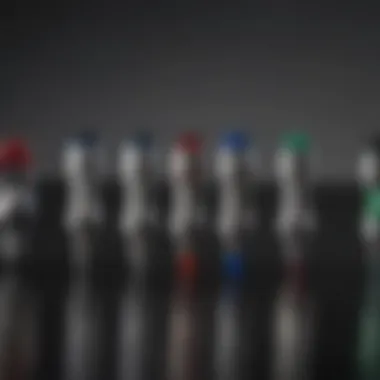
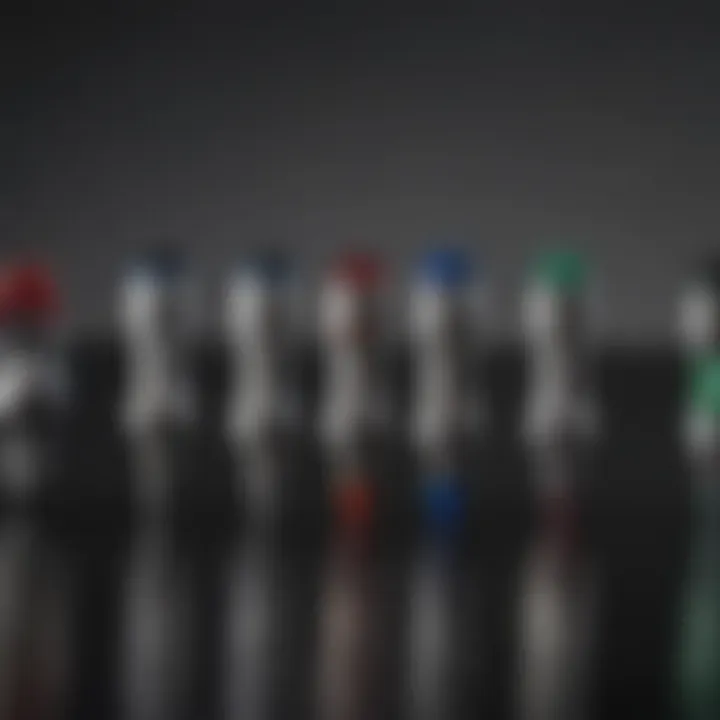
Intro
The sprayer nozzle is an essential component in agricultural practices, directly impacting the efficacy of chemical application. Understanding the replacement process is critical for both beginner and seasoned farmers. Efficient nozzle replacement can enhance coverage, increase efficiency, and reduce waste. In this guide, we will explore various aspects of sprayer nozzle replacement, from their significance to hands-on techniques and maintenance practices. The goal is to empower users to execute efficient spraying techniques that contribute positively to agricultural sustainability.
Topic Overview
Definition and Importance
Sprayer nozzles are devices that convert liquid into a spray. They dictate the pattern, droplet size, and volume of the application. Proper selection and maintenance of nozzles are crucial since they affect material distribution and plant health. Inefficient nozzles can lead to uneven application, resulting in wasted inputs and possible crop damage. Therefore, regular nozzle replacement is pivotal for optimal performance.
Brief History and Evolution
The history of sprayer nozzles traces back over a century. Initially, nozzles were simple devices lacking precision. As technologies evolved, so did the design and materials used for nozzles. Today, there are various types of nozzles designed for diverse applications, including flat fan, hollow cone, and turbo. Each type has specific uses, dictated by the needs of the application and various environmental factors.
Key Techniques and Innovations
Sustainable Farming Practices
In order to ensure productivity while being environmentally conscious, farmers are increasingly adopting sustainable practices. Nozzle replacement plays a crucial role in this transition. The use of efficient nozzles can reduce chemical usage, lower the risk of runoff, and promote a healthier ecosystem. For instance, drip nozzles help deliver water and nutrients directly to the root zone, minimizing waste.
Advanced Agronomic Technologies
Modern agricultural industries are leveraging advanced technologies. Innovations such as precision agriculture utilize data-driven insights to optimize spraying processes. Technologies like variable rate application rely on accurate nozzle functioning to adapt applications based on field variability, significantly enhancing resource efficiency.
Practical Applications
Step-by-Step Guides
- Preparation: Gather tools such as a replacement nozzle, wrench, and protective gear.
- Disconnect the Sprayer: Ensure that the sprayer is turned off and drained of liquids.
- Remove the Old Nozzle: Use a wrench to unscrew the old nozzle carefully.
- Clean the Fitting: Check for debris or wear in the fitting and clean if needed.
- Install the New Nozzle: Screw in the new nozzle, ensuring it fits snugly.
- Test the System: Reconnect and test for leaks before resuming operations.
Case Studies or Real-World Examples
Farmers who regularly replace nozzles report improved crop yields and decrease in chemical costs. For example, a case study from Growszi showcased a potato farm that switched to flat fan nozzles, resulting in a 30% reduction in pesticide use while maintaining crop health and yield.
"Regular maintenance of sprayer nozzles is key to ensuring not only the health of crops but also the sustainability of farming practices." - Expert Agronomist
With the insights discussed, readers can appreciate the critical role sprayer nozzle replacement plays in effective agricultural practices. It is not merely a task; it is a strategic approach to ensuring the success and sustainability of farming operations.
Understanding Sprayer Nozzles
Sprayer nozzles are a fundamental component in the realm of agricultural and horticultural practices. They play a crucial role in effective spraying operations by controlling the size and pattern of droplets released during application. Understanding sprayer nozzles is paramount for enhanced performance and optimized resource usage in various spraying tasks.
Definition and Functionality of Sprayer Nozzles
Sprayer nozzles can be defined as devices designed to convert the liquid chemical formulations into a fine spray or mist. This transformation is essential for ensuring that the active ingredients reach the intended targets efficiently. The functionality of nozzles is primarily defined by their designs, which may vary from flat fan to cone shapes, each designed for specific spraying tasks. It is the nozzle that dictates the angle and droplet size in the spray pattern. For instance, flat fan nozzles are often used for broad applications, while cone nozzles create a concentrated spray, suitable for targeted areas. Understanding how these elements work together helps users make informed decisions during application.
Importance of Nozzle Selection
The selection of the right nozzle can dramatically affect the efficacy of spraying applications. Choosing the incorrect nozzle not only leads to poor coverage but can also result in wasted products and increased chemical run-off, which is detrimental to the environment. It is essential to evaluate factors such as the type of crop, the specific pest or weed being treated, and the local environmental conditions when selecting a nozzle. Here are some key points to consider in nozzle selection:
- Application Type: Different applications require different types of nozzles. Flat fan nozzles for larger areas or cone nozzles for precise direction.
- Droplet Size: This affects how the liquid mixes with air and may help prevent drift.
- Pressure: Nozzles operate differently under varying pressure settings.
- Compatibility: Ensure that the selected nozzle attaches securely to the sprayer.
Making the right nozzle choice not only enhances the effectiveness of the spray but also promotes sustainable practices in agriculture.
"A proper understanding of sprayer nozzles can lead to significant improvements in agricultural efficiency and effectiveness."
In summary, understanding sprayer nozzles involves more than just knowing their basic functions. Comprehensive knowledge about their selection and application is vital for achieving successful outcomes in spraying practices.
Types of Sprayer Nozzles
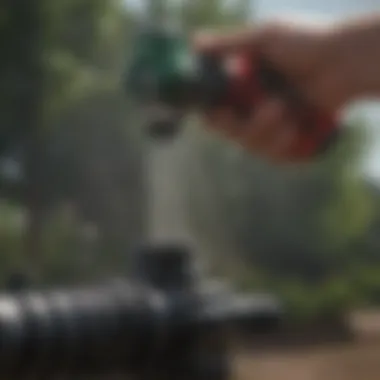
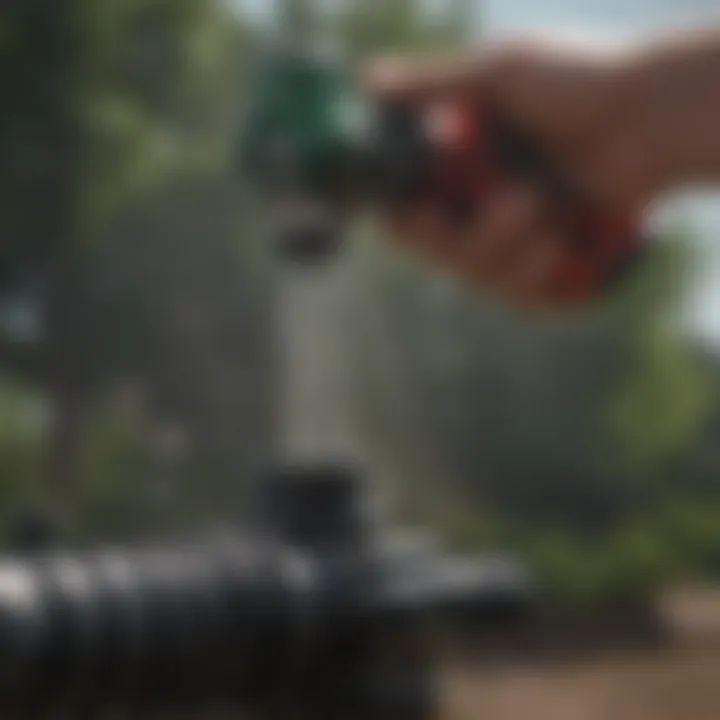
Sprayer nozzles are vital components of spray equipment in agriculture. Their design and function directly affect the application of various chemicals, whether it is fertilizers, pesticides, or herbicides. Understanding the different types of sprayer nozzles is crucial. It helps farmers make informed decisions that can enhance efficiency and effectiveness in their spraying applications. Each nozzle type has unique characteristics and is suited for specific tasks. Therefore, knowing their advantages and limitations can lead to better crop protection and an overall boost in agricultural productivity.
Flat Fan Nozzles
Flat fan nozzles create a thin, fan-shaped spray pattern. They are commonly used in various applications including field, orchard, and vegetable spraying. This type of nozzle is particularly effective for applying pesticides onto crop foliage as it allows for good coverage. However, the pressure significantly impacts the droplet size and distribution. A higher-pressure setting produces finer droplets but may lead to drift if the conditions are windy. Farmers should pay attention to the operating pressure when using flat fan nozzles to ensure the desired spray quality.
Cone Nozzles
Cone nozzles produce a conical spray pattern and are typically used for larger areas. Their design allows for a more targeted application of liquid, which can reduce waste. Cone nozzles work well in situations where you need to penetrate dense foliage. However, they may not perform as well in windy conditions due to the larger droplet size. It's important to note that the height of the nozzle above the target can also affect spray distribution. Farmers must adjust the height accordingly to achieve optimal coverage.
Air Induction Nozzles
Air induction nozzles are designed to mix air into the liquid spray, creating larger droplets. This characteristic helps in minimizing drift, making them ideal for applications in windy conditions. They offer more control over how much chemical reaches the target area while reducing the chances of off-target application. These nozzles are an excellent choice for high-volume spraying. However, the larger droplet size might lead to less coverage on very fine foliage. Farmers should consider the specific conditions they are working in before choosing air induction nozzles.
Disc Nozzles
Disc nozzles function by forcing liquid through a small opening to create a defined spray pattern. They are especially useful for applications requiring a uniform distribution. The main advantage of disc nozzles is their efficiency in reducing pressure changes which can otherwise affect droplet size. Good selection and adjustment can lead to precise applications which have significant effects in pest management programs. However, they might require more frequent cleaning to avoid blockages than other nozzle types.
Adjustable Nozzles
Adjustable nozzles allow for modifications in the spray pattern and droplet size by changing the angle or flow rate. This flexibility makes them particularly versatile, accommodating various spraying needs and conditions. Farmers can adjust the nozzle to match the specific crop and chemical application without needing to change the nozzle itself. Despite their advantages, improper adjustments can lead to uneven coverage or waste of resources. Understanding proper adjustments is essential for making the most of adjustable nozzles.
Signs of Nozzle Wear and Tear
Understanding the signs of nozzle wear and tear is crucial for anyone involved in agricultural or horticultural practices. Recognizing these signs can help in maintaining the effective performance of spraying equipment, which in turn influences crop health and yield. Nozzle failure can lead to uneven application of chemicals or water, adversely affecting plants and potentially causing crop loss. This section will emphasize what to look for in both visual signs of damage and performance issues that may arise during spraying.
Visual Indicators of Damage
Visually inspecting the nozzles can often reveal obvious signs of damage. Here are some key indicators to look for:
- Cracks or Breaks: Small fissures can develop due to wear and thermal stress. Even minor cracks can compromise the spray pattern.
- Corrosion: Metal nozzles may exhibit signs of rust or corrosion, especially when exposed to certain chemicals. This not only affects durability but also performance.
- Uneven Wear: If one side of a nozzle shows more wear than the other, this suggests improper usage or attachment issues.
- Clogging: Debris accumulation inside the nozzle can lead to blockages. Occasionally, a quick rinsing won't suffice if buildup persists.
"Regular visual inspections can catch problems early, saving both time and resources."
Keeping a checklist for these indicators allows for a proactive approach to maintenance. An early intervention can prevent minor issues from escalating.
Performance Issues During Spraying
Performance issues are often more subtle and can manifest in various ways that impact application efficacy. Key performance problems include:
- Inconsistent Spray Pattern: If the spray is uneven or sprays in a reduced area, it is a clear sign of a malfunction. This could stem from wear or clogging.
- Decreased Flow Rate: If the nozzle delivery has slowed down, recalibration or replacement may be necessary. This can result in insufficient chemical application.
- Dripping or Leakage: Unexpected dripping while not in use indicates a failure in the nozzle seal. This can waste resources and affect effectiveness during application.
- Increased Drift: Nozzles that have become worn can create finer droplets, resulting in increased drift. This can easily lead to wastage and potential damage to neighboring crops.
Understanding these performance issues ensures you can address them timely, protecting the health of your crops and the efficiency of your operations. It's not just about replacing the nozzle; it is also about understanding its state and impact on agricultural practices.
Preparing for Nozzle Replacement
Preparing for the replacement of sprayer nozzles is a crucial step that should not be overlooked. This phase ensures that you are equipped with the right information and tools before you proceed with the actual replacement. A well-prepared approach can significantly reduce the time required for the task, minimize mistakes, and enhance operational efficiency. Proper preparation also contributes to improved safety, which is especially important when dealing with agricultural chemicals.
Being methodical about this preparation means understanding not just what tools are required, but also the potential hazards involved. It is vital that one evaluates the condition of the sprayer system, identifies the required nozzle specifications, and gathers all necessary equipment before starting. This not only streamlines the process but also ensures that you do not forget any essential step during the actual replacement. An organized approach can improve the overall spraying performance by ensuring that the new nozzle fits perfectly and operates effectively.
Necessary Tools and Equipment
Before starting the nozzle replacement, it is essential to gather the necessary tools and equipment. Having everything at hand allows for a smooth operation without unnecessary interruptions. Here is a list of common tools and items you may need:
- Wrench Set: A variety of wrenches, such as adjustable and socket wrenches, can help in loosening or tightening nozzles.
- Screwdrivers: These are necessary for any screws that may be involved in securing the nozzle.
- Replacement Nozzles: Ensure you have chosen the right type of nozzle for your spraying needs.
- Sealants or O-rings: These components can help ensure a secure and leak-proof assembly.
- Protective Eyewear: Safety glasses are crucial to protect your eyes from potential chemical sprays.
- Gloves: Chemical-resistant gloves are essential when handling pesticides or herbicides.
Having these tools organized and ready will not only help in efficiency but promote safety during replacement.
Safety Precautions to Consider
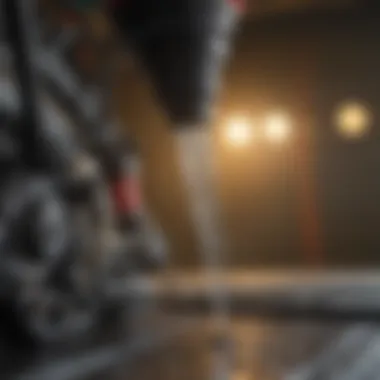
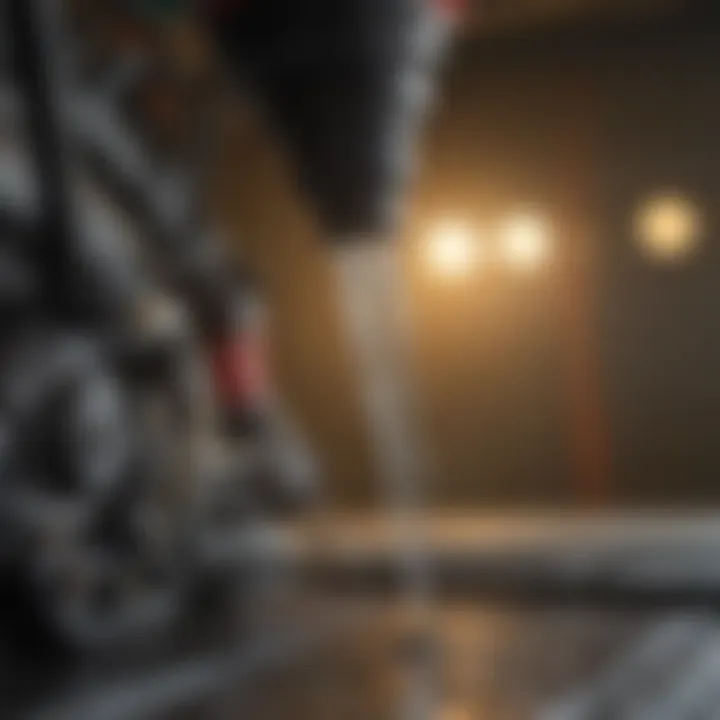
When replacing sprayer nozzles, safety must be a top priority. Working with sprayers involves handling chemicals that may be hazardous to health. Here are several critical safety precautions to keep in mind:
- Read Manufacturer Guidelines: Always consult the manufacturer's manual for specific instructions related to nozzle replacement.
- Check for Residues: Prior to starting, ensure that there are no residual chemicals in the sprayer.
- Work in a Well-Ventilated Area: Adequate ventilation is essential to prevent inhalation of chemical fumes.
- Wear Proper Attire: Use protective clothing, gloves, and eyewear to minimize exposure to harmful substances.
- Dispose of Old Nozzles Properly: Old nozzles that may have chemical residues should be disposed of in accordance with local regulations.
Taking these precautions seriously can greatly reduce the risk of accidents and ensures that the replacement process is carried out safely.
Step-by-Step Guide to Nozzle Replacement
The process of replacing a sprayer nozzle is a vital practice for maintaining the efficiency of spraying tasks in agriculture and horticulture. When done correctly, this step-by-step guide can enhance performance, reduce chemical waste, and increase crop yields. In this section, we will discuss detailed actions to replace a nozzle, emphasizing the importance of thoroughness in every stage.
Removing the Old Nozzle
Before any replacement can take place, the first task is to remove the old nozzle. This action may seem straightforward, but there are specific steps to consider. Start by ensuring that the sprayer is off and drained of any liquid to prevent accidental sprays. Check for any visible wear or damage on the old nozzle. Use a proper wrench or pliers to carefully unscrew the nozzle. If the nozzle is stuck, applying a penetrating oil can assist in loosening it. It is important not to apply excessive force, as this may damage the attachment. Once removed, inspect it closely for signs of wear—cracking or clogging may indicate it needed replacement long ago.
Selecting the Correct Replacement Nozzle
Upon successful removal of the old nozzle, the next step involves selecting an appropriate replacement. The right choice depends on several factors, including the sprayer's application and the fluid being sprayed. Considerations:
- Flow Rate: Ensure the new nozzle matches the required flow. Look for specifications on the original nozzle or in the sprayer's user manual.
- Spray Pattern: Different applications require different spray configurations. Decide if a flat fan, cone, or air induction nozzle is most suitable.
- Material Compatibility: Check that the new nozzle can handle the chemicals involved. Some materials experience corrosion over time.
With these factors considered, verify that the selected nozzle is the correct size. A slight mismatch can affect performance significantly.
Installing the New Nozzle
Once the replacement nozzle is chosen, the installation process begins. Carefully position the new nozzle into the sprayer's body. Hand-tighten it initially to avoid cross-threading. After securing it by hand, use a wrench for final tightening. However, keep in mind not to overtighten, which could lead to damage. Once installed, inspect the area for any visible gaps or issues. It is prudent to run a quick test to ensure no leaks are present. Apply some spraying pressure and observe whether the new nozzle delivers the fluid uniformly and consistently. If you notice irregular patterns, further adjustments may be necessary to ensure optimal operation.
A thorough nozzle replacement process can significantly affect overall spraying efficiency, which in turn affects crop yield and chemical usage. Ensuring attention to detail can lead to success in agricultural practices.
In summary, replacing a sprayer nozzle involves systematic steps. Proper removal, selection, and installation are crucial to ensuring that your sprayer operates effectively, ultimately benefiting your agricultural practices.
Post-Replacement Checks
After you have replaced the sprayer nozzle, it is essential to conduct thorough post-replacement checks. These checks help ensure that the new nozzle is functioning correctly and providing the performance you need. Skipping this step can lead to ineffective spraying, wasted resources and even potential crop damage. Therefore, a systematic approach to post-replacement checks will enable you to maximize efficiency and sustainability in your spraying applications.
Testing Nozzle Functionality
The first step in the post-replacement checks is testing the functionality of the new nozzle. This involves examining several key factors to confirm that the nozzle is working as intended.
- Check for Leaks: Inspect the connection between the nozzle and the sprayer body. Look for any signs of leakage that could compromise application efficiency.
- Spray Pattern Evaluation: Activate the sprayer and observe the pattern of the spray. Ensure that it matches the specified pattern for the nozzle type you are using. Misalignment can affect coverage.
- Pressure Monitoring: Ensure that the operating pressure is within the recommended range for your nozzle. Too high or too low pressure can alter the spray characteristics.
By conducting these tests, you can identify any immediate issues and rectify them before starting an actual spraying operation. It is wise to perform these checks regularly to maintain optimal performance.
Adjustments for Even Coverage
Once you have confirmed that the nozzle is functioning correctly, the next focus should be on adjustments for achieving even coverage across your target area. Uneven coverage can lead to inefficient chemical use and inconsistent results in field applications. Here are some important adjustments to consider:
- Nozzle Height: The placement of the nozzle in relation to the target surface can greatly affect spray distribution. Make necessary height adjustments based on the type of nozzle used and the specific application requirement.
- Spacing Between Nozzles: When using multiple nozzles, ensure proper spacing to avoid overlap or gaps in coverage. This arrangement should suit the specific requirements of the crop or area you are treating.
- Flow Rate Adjustments: Adjust the flow rate if needed. Too high a rate can lead to excessive runoff, while too low a rate might not provide adequate treatment.
Proper adjustments not only improve application efficacy but also contribute to the sustainability of your practices. This diligence reduces environmental impact and helps in the responsible use of resources.
Remember: Consistent monitoring and adjustments after replacing your nozzle can significantly enhance the overall spraying experience, ensuring that your agricultural efforts are both effective and economically viable.
Maintenance Best Practices
Maintaining sprayer nozzles is essential for effective agricultural practices. Regular maintenance ensures the longevity and efficiency of these crucial components. Properly cared-for nozzles help in achieving uniform spray patterns and optimal chemical application, which ultimately leads to better crop yields and reduced waste. Ignoring maintenance might result in uneven distribution, which can cause both over-spraying and under-spraying. This section will cover key maintenance best practices that every user should consider.
Regular Cleaning Procedures
Cleaning sprayer nozzles is a crucial step after every use. If left unclean, residue can accumulate, affecting spray quality. Here are some effective cleaning procedures:
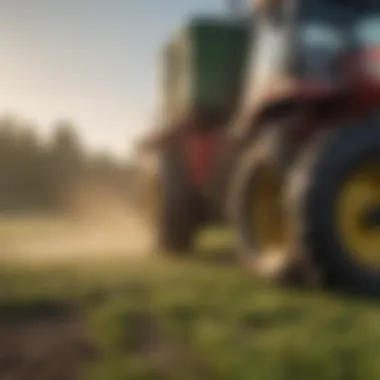
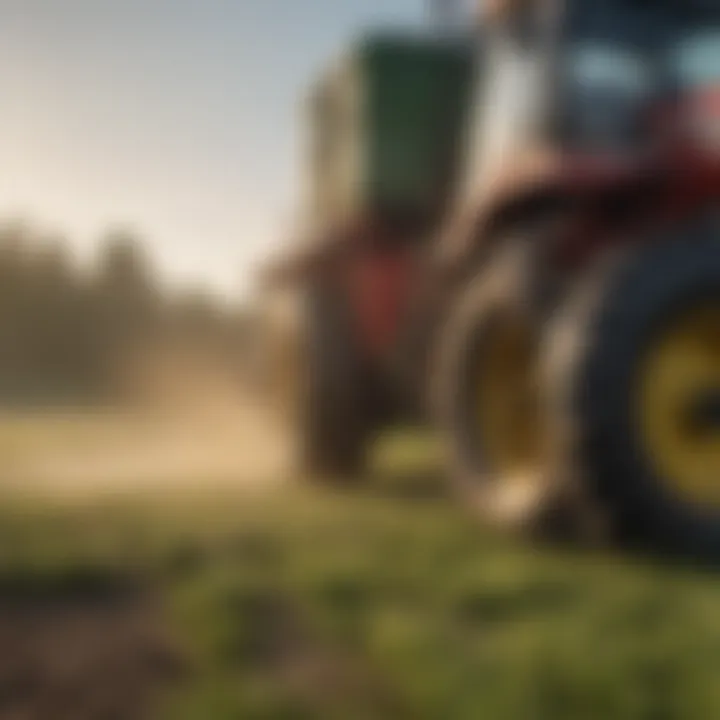
- Flush the System: After use, flush the nozzle with clean water to remove any leftover chemicals. This maintains the integrity of both the nozzle and the sprayer system.
- Soak Nozzles: For thorough cleaning, immerse the nozzles in a mild detergent solution. Make sure to follow the manufacturer's instructions on descaling agents to avoid damage.
- Use Soft Brushes: Employ soft-bristled brushes to gently scrub the nozzle orifices. This gets rid of stubborn residues without scratching the surface.
- Inspect Gaskets and Filters: While cleaning the nozzles, check the gaskets and filters as well. Clean or replace them if they show signs of wear, ensuring a tight seal and proper function.
Regular cleaning not only enhances performance but also extends the lifespan of the nozzles.
Routine Inspection Schedule
Establishing a routine inspection schedule is vital for identifying wear before it leads to more severe issues. Consider the following points when setting this schedule:
- Frequency: Inspect nozzles at least once a month or more often during peak usage seasons. Regular inspections catch problems early.
- Physical Examination: Look for cracks, chips, or any changes in the nozzle shape. Damaged nozzles should be replaced immediately to maintain spray accuracy.
- Performance Testing: Occasionally test spray patterns. Variations can indicate wear or clogging. Comparing results against manufacturer specifications can help gauge effectiveness.
- Documentation: Keep logs of inspections and maintenance actions. This practice can highlight patterns indicating the need for a more thorough replacement plan.
Regular inspections and timely maintenance keep sprayer nozzles functioning efficiently.
In summary, adopting these maintenance best practices leads to improved performance and reduced downtime. Farmers who prioritize these essential steps can enjoy smoother spraying operations and better crop health.
Common Mistakes During Replacement
Replacing sprayer nozzles is not a trivial task. It requires attention to detail to ensure optimal performance of your sprayer system. Mistakes during this process can lead to inefficiencies, increased costs, and even crop damage. In this section, we will explore some of the most common errors made during nozzle replacement and outline their implications. Understanding these mistakes will help you ensure a successful replacement.
Using Incorrect Nozzle Type
One of the most frequent errors is using the wrong nozzle type. Nozzles vary significantly in terms of spray patterns, droplet sizes, and flow rates. This means that selecting an inappropriate nozzle for the task at hand can drastically affect the application efficiency.
When using the incorrect nozzle:
- Coverage Issues: You may not achieve even coverage over your crops, which can lead to poor plant health and insufficient pest control.
- Increased Waste: An unsuitable nozzle can result in overspray, wasting precious resources such as chemicals or water.
- Regulatory Concerns: Some products have specific application requirements. Not adhering to these guidelines can lead to non-compliance with local regulations.
Before making a replacement, assess the specific needs of your operation. This includes considering the target crop, the chemical being applied, and environmental conditions. Carefully refer to manufacturer guidelines or consider reading additional sources, like Wikipedia for sprayer nozzle specifications,
Neglecting Proper Tightening
Another common mistake is inadequate tightening of the nozzle. A nozzle that is not securely fitted can lead to a range of problems.
- Leaking: Loose nozzles can cause unwanted leaks, resulting in inefficient spraying and potential environmental harm.
- Performance Variability: A loosely attached nozzle may shift during operation, causing inconsistent spray patterns and flow rates.
- Equipment Damage: Over time, continual loosening can damage both the nozzle and the sprayer, leading to costly repairs.
To avoid this mistake, always follow the manufacturer's installation instructions. Using the right tools, like torque wrenches, can also help to achieve the necessary tightness without over-tightening, which can cause cracks or other damage.
Remember: Taking time to choose the correct nozzle type and ensuring proper tightening can greatly enhance your spraying efficiency and effectiveness.
Environmental Considerations
Understanding how sprayer nozzle replacement affects the environment is crucial for responsible agricultural and horticultural practices. The choice of nozzle impacts not only the efficiency of the application but also the ecological footprint of those operations. In this section, we will explore two vital aspects: the impact of nozzle selection on chemical use and sustainable practices in spraying applications.
Impact of Nozzle Selection on Chemical Use
Nozzle selection plays a significant role in how chemicals are applied and distributed across the target area. Different nozzles offer varying droplet sizes and spray patterns, directly influencing the efficacy of the products used. Proper nozzle type can minimize chemical wastage and ensure that the application targets the intended area effectively.
For instance, using a nozzle that generates larger droplets can help reduce the drift caused by wind. This is particularly important when working in proximity to sensitive areas, such as nearby water bodies and residential zones. Furthermore, selecting the right nozzle can lead to a more uniform distribution of the spray, ensuring optimal coverage and reducing the possibility of both under-application and over-application of chemicals.
Consider the following key points when selecting nozzles based on chemical use:
- Droplet Size: Larger droplets reduce drift, while smaller droplets enhance coverage.
- Application Pressure: Higher pressure can lead to finer droplets, which may not be desirable for all applications.
- Flow Rate: Matching the flow rate to the target application rate is essential for maintaining efficiency.
"The correct nozzle choice can lead to reduced environmental impact while maximizing treatment effectiveness."
Sustainable Practices in Spraying Applications
Sustainable practices can be integrated throughout the spraying process, starting from the selection of nozzles to their maintenance. This approach helps reduce the overall input costs while promoting environmental health. Implementing sustainable practices in spraying applications supports achieving the following goals:
- Minimizing Chemical Runoff: By choosing the appropriate nozzle type and ensuring it remains well-maintained, wastage can be minimized. This directly affects how chemicals leave the target area and enter waterways.
- Improving Ecological Balance: Using precision spraying technology helps maintain beneficial organisms in the environment. This balance can be disrupted through improper chemical application, leading to a loss of biodiversity.
- Resource Efficiency: Sustainable practices help in conserving resources, making the applications more productive and effective.
To foster sustainable practices in your operations, consider the following methods:
- Regular Training: Educating workers about the proper use and maintenance of sprayer nozzles.
- Monitoring Systems: Implementing technology that aids in real-time monitoring of spraying activities can improve application efficiency.
- Feedback Loops: Gathering data on application outcomes to adjust practices accordingly.
By addressing these environmental considerations, farmers can contribute not just to their productivity but also to the well-being of the ecosystem. Understanding the connection between nozzle choice and sustainability is key to optimizing agricultural practices.



